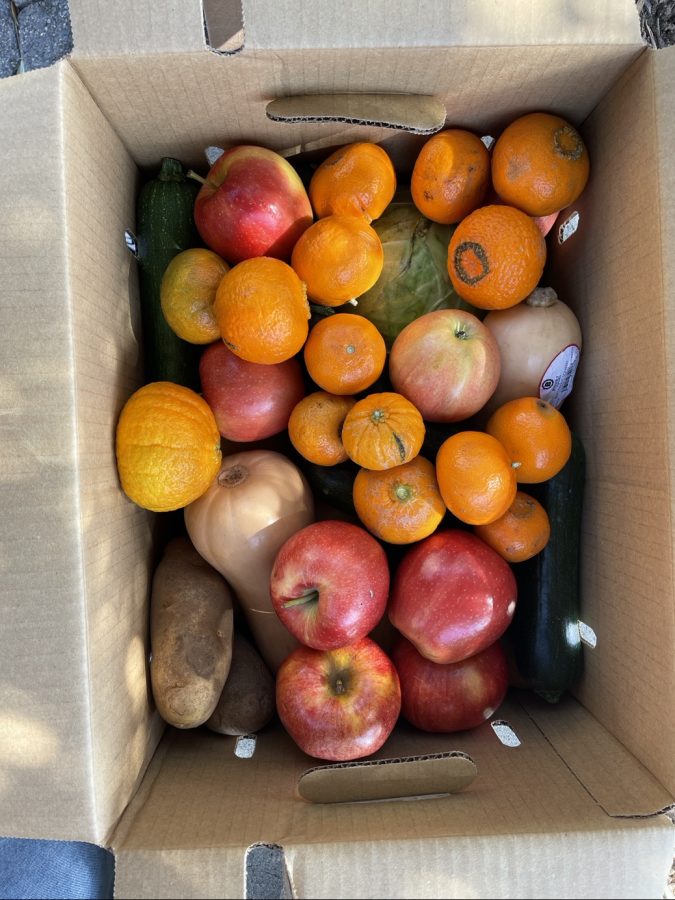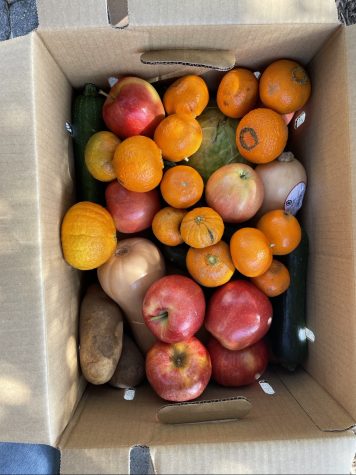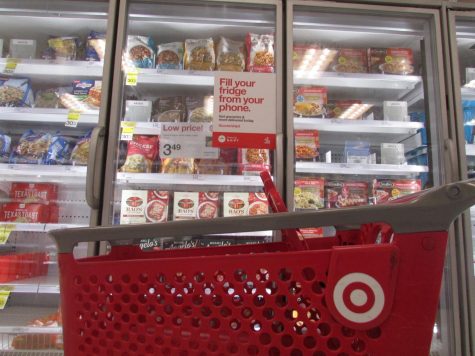San Mateo residents juggle which basic need they’ll prioritize
Don Uy-Barreta volunteers at the San Francisco-Marin Food Bank. He and his family pack groceries that would then be distributed to the people. From his experience, he says that food insecurity is prevalent in the county and exacerbated by the COVID-19 pandemic.
“At the end of our volunteering shift, they tell us how many pounds the volunteers have put together,” says Uy-Barreta, who teaches economics at Skyline College. “And they did mention that since COVID, there’s been a big increase, a big uptick in food insecurity along with homelessness and mental issues.”
In December, Forbes listed San Mateo County as the fourth richest county in the country, with a median household income of $122,641 according to U.S. Census data. The Silicon Valley, opulent to jobs in tech spanning from southern parts of the Peninsula up to the South Bay, makes living in the Bay Area glamorous and filled with glamor.
But despite being dubbed a rich county, expenses in the county are also believed to be expensive. Living in a wealthy neighborhood doesn’t equate to a higher quality of living. Therefore, food insecurity exists even in the Bay Area, not by choice but as a consequence of having to prioritize other necessities in everyday life.
Justin Watkins, Get Healthy San Mateo County (GHSMC)’s senior community health planner, work with community-based organizations and NGOs in addressing food insecurity around the county. One of their partners, Second Harvest of Silicon Valley, sponsors food banks across the Bay Area. said that their distribution sites grow compared to the numbers pre-pandemic.
“They’re seeing their distribution sites, grow by two, three, in some sites, even four times as much as before the pandemic,” Watkins said. “So what that tells us is we’re seeing more residents are in need of emergency food resources.”
CalFresh aims to bridge inequities toward healthy and nutritious food. For Rommel Silva, outreach and center supervisor for the San Mateo County Human Services Agency (HSA), CalFresh is a “safety net program for those that are struggling to purchase food.”
According to Silva, there are 17,132 CalFresh cases in the county and a total of $4,451,118 were used as benefits for May. Of all the areas, Daly City, Redwood City, San Mateo, South San Francisco and East Palo have the highest number of CalFresh recipients.
CalFresh recipients jump to more than twice their number this year in only seven years. The GHSMC reports that 7,968 San Mateo County residents are CalFresh recipients, while 30% to 40% of “residents are food insecure but ineligible for benefits” based on 2015 reports.
This is more than twice the number of 7,968 that was collected in 2015 by the Get Healthy San Mateo County (GHSMC), a community collaborative under San Mateo County Health’s Public Health Policy and Planning Division.
CalFresh eligibility also follows the Federal Poverty Level, which according to Silva is much lower than local guidelines as especially in the Bay Area, “everything cost so much.”
The government sifts people who can be eligible for CalFresh or the Supplemental Nutrition Assistance Program (SNAP) based on the Federal Poverty Guideline. This could be limiting especially for those who aren’t eligible for the benefits despite their financial situation. Uy-Barreta believes that everyone needs support, but there is justification for this metric because the government’s resources are limited.
“If they don’t do it this way, another way that the government can distribute these resources, this food or whatever, is through a lottery system,” Uy-Barreta says.
Who is considered food insecure?
As an economics professor, Uy-Barreta said that there are many definitions for the word “food insecurity,” but he describes an individual experiencing food insecurity if they “lack access to proper food” or if they don’t meet the daily caloric intake required for a healthy lifestyle.
“A diet shouldn’t be composed of Cheetos and iced tea and sugary beverages,” Uy-Barreta said. “We’re looking at something more nutritious, like a certain amount of grains or vegetables or fruits or an amount of dairy.”
Chad Thompson is the director for SparkPoint at Skyline College, an on-campus service center for financial coaching and student basic needs. He says that a well-respected metric to classify an individual as food insecure is when they are not eating as much as they like to or if “they don’t know where their next meal might be coming from.”
“The very basic idea of being uncertain is very closely related for me to food insecurity,” Thompson said. “You are uncertain if you will have the food that you need that day, or if you are uncertain where you will get your next meal.”
Rent and Housing – Biggest drainers of income
Housing costs and rent remain the greatest component of living expenses in the Bay Area. This issue isn’t exclusive, however. With more of the household income being allocated for housing and rent, it limits the budget for other expenses like food.
In 2017, the non-profit firm California Budget & Policy Center listed San Francisco, Marin, San Mateo, Santa Clara and Alameda counties to be the top five counties with the highest “cost to make ends meet.” The median cost of rent in San Mateo County for a two-bedroom shelter that year is $2,980. Five years later, Rental and housing costs continue to skyrocket as presented in annual reports. In March, CBSNEWS reports the median cost of a two-bedroom apartment is $3,220.
Thompson said that the lack of affordable housing is a “regional issue” in the Bay Area.
“Overall, housing is the biggest one that people think of in terms of cost of living,” Thompson said. “But when you live in an expensive area, it doesn’t just mean that the housing is expensive, everything is expensive. It’s a part, it’s all connected.”
“I know, particularly in Daly City, the Bay Area in California in general, a significant portion of people’s income goes towards rent. So we’re very aware of that,” Tatum Mothershead said, Daly City’s director of economic and community development.
Mothershead said that only a third of an income should be allotted for housing, with the rest for other necessities like food and medicine.
“There’s a lot of families and households that are paying more than a third of their income towards housing costs. So I would say housing costs are probably the primary concern we have in terms of how that it’s affecting the quality of life,” Mothershead said.
When people receive their bills at the end of the month, rent, utilities, and other subscriptions like cable or internet get paid and the rest, including food, gets negotiated.
“First and foremost, people are going to make sure they have a place to live and put their money towards that,” Thompson says. “Then whatever they might have available after, they will put towards their food. And maybe that’s not enough.”
Silva agrees and said that even people that CalFresh recipients tend to max out their benefits before the end of the month, and put them in a dilemma of having to prioritize bills or buy food.
Distance – a barrier to food access
Accessibility to food resources also warrants food insecurity. Mothershead explains that mobility limits one’s ability to travel for food.
“I do think people’s radius for food depends on their mobility, their access to transit,” Mothershead said.
She explains that people with personal vehicles have a wider radius of food resources they could drive into. For people that rely on public transit, however, she says that it could be difficult since they only come once an hour or there are no food resources that are accessible within walking distance.
SparkPoint also serves the local community with free drive-thru grocery distribution every week that serves around a thousand households per week.
Uy-Barreta also pointed out that food pantries and groceries at Skyline College aren’t accessible to everyone, with the college nestling up the hill. Aside from personal vehicle, other means to get into Skyline would be riding the Skyline College Express shuttles that drop off people from the college to the Daly City Bart station and vice-versa or SamTrans 121 bus (Northbound to Pope Street and Bellevue Avenue; Southbound to Skyline College) and 140 bus (Eastbound to SFO Airtrain; Westbound to West Manor Drive/Palmetto Avenue). Both buses are scheduled to come hourly.
“Sometimes the shuttles may be late, you may miss out on the line,” Uy-Barreta said. “So if we can get these food pantries, or this different type of resources closer to the community within reach, then I think it’s going to be much better.”
Time – a factor for meal preparation
Consumption behavior has also changed over the decades with the rise of food technologies and with people adapting to today’s work-life balance while trying to be healthy. Working individuals tend to consume food away from home (FAFH) from food entities like fast-food chains and restaurants than home-cooked meals or food at home (FAH).
In 2018, the U.S. Department of Agriculture (USDA) published research studying food consumption trends of Americans from 1987 to 2017 and found out that “spending on FAFH surpassed spending on FAH for the first time in 2010.”
“Households not only consider affordability when making food choices, but also the time it would take to prepare the foods. If the primary meal planner in the household gets a job, then that person’s time becomes more valuable. Time-intensive meal preparation thus becomes less attractive and motivates increased consumption of away-from-home prepared meals…” the USDA’s Economic Research Service (USDA ERS) wrote in correspondence on forces that increased spending on FAFH.
Thompson says multiple considerations determine whether a family can cook at home or not: working multiple jobs, the commute from home to work and vice versa, the physical space to cook, and responsibilities as a parent or a caregiver are some examples.
“For individuals in those situations, fast food, for instance, which most will agree is less healthy than a lot of options that you might be able to make yourself,” Thompson said. “Obviously, there’s a strategy to do that – that is going to save people time.”
While both Uy-Barreta and Thompson both have backgrounds in economics, the two have different opinions on an individual’s consumption of fast food and restaurant.
For Uy-Barreta, people relying on fast food and restaurants may also be classified as food insecure as they consume a great amount of sodium and MSG; for Thompson, consuming fast food is a convenient choice for people with less time or physical space to prepare food.
The impetus of COVID-19 necessitated lockdown and work from home has become the new norm for some employees. Without having to deal with traveling and morning rituals, people may have more hours for sleep, chores, cooking, and self-care. This luxury, however, isn’t for everyone. For instance, cashiers who belong to the low-income job stratum, are still essential workers.
What is being done and what can be done?
Making sure people are informed of the resources and advocating for affordable housing is crucial in curbing food insecurity.
GHSMC aims to address key issues critical around the county: healthy housing, healthy neighborhoods, healthy schools and a healthy economy.
“All of the work that Get Healthy does is really to address inequities, and food insecurity is the result of inequities in our community,” Watkins said.
Watkins encourages residents to look into programs like CalFresh and free and reduced-price meals that are being implemented for students in public schools around the county. Throughout the pandemic, Watkins said that their organizations work with several school districts around the county to provide meals to students. He said that they implemented a “grab and go model” for parents to pick up meals.
San Mateo County Human Services Agency is hoping to serve a larger community with outreach. Silva said that there is a lot of misinformation in the community and he aims to help the underserved population.
“I see that especially in the immigrant communities here, where there’s that fear if the government knows you know who they are where they live,” says Silva. “We always do our best to give them the right information and to clarify any of these misconceptions.”
Aside from promoting on social media and their website, Silva also said that they have two mobile offices that travel around the county to invite people to sign up for CalFresh. They conduct interviews and provide EBT cards on-site to people who qualify.
In April of last year, the California Department of Social Services (CDSS) mandated All County Letter (ACL 21-52) to offer new or existing MediCal members CalFresh applications “at any point of contact” according to Silva. This direction was supposed to be implemented at the start of this year but was extended till 2023. Silva said that they are working on getting it implemented sooner.
For Mothershead, having wages match people’s expenses may allow more budget for food rather than solely be allocated for rent.
“There may be people that work 40 to 80 hours a week that aren’t bringing in enough income to cover their basic needs,” Mothershead said. “So, it’s not just an employment number, but maybe an issue with the actual income.”
“When we’re able to work with the county and cities to address affordable housing, living wages, when we’re able to advocate for living wages and work with cities and counties to implement living wages, then the residents of San Mateo County win and you’re able to work to address food insecurity that way,” Watkins said.




